Knorr-Bremse Bundle
How Does Knorr-Bremse Dominate the Transportation Tech Arena?
From the bustling railways to the highways, Knorr-Bremse's impact on global mobility is undeniable. Founded over a century ago, the company has evolved from a pioneer in train braking systems to a global leader in braking and related systems for both rail and commercial vehicles. But how does Knorr-Bremse maintain its edge in a fiercely competitive market?
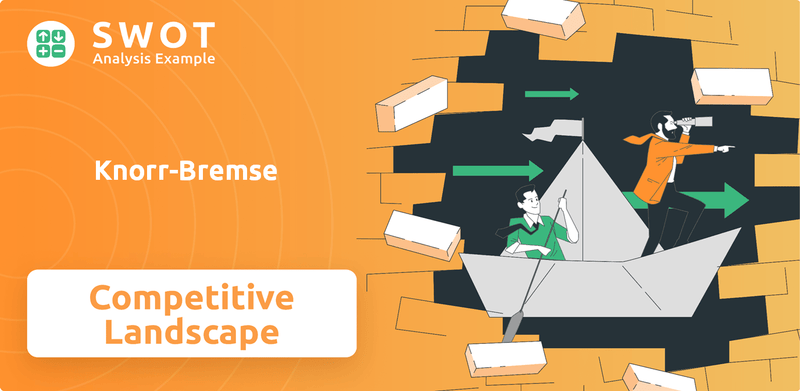
To truly understand Knorr-Bremse's position, this analysis dives deep into the Knorr-Bremse SWOT Analysis, exploring its competitive landscape, key competitors, and market share dynamics. We'll dissect the company's strategic overview, examining its financial performance and industry analysis to uncover its competitive advantages. This exploration will also cover Knorr-Bremse's global market presence and the challenges it faces, including the impact of electric vehicles and innovation in autonomous driving.
Where Does Knorr-Bremse’ Stand in the Current Market?
Knorr-Bremse holds a significant market position in the global rail and commercial vehicle sectors, particularly excelling in braking systems. The company is recognized as a leading supplier in these areas. Its operations span across various product lines, including braking, door, climate control, and driver assistance systems, catering to a diverse customer base of vehicle manufacturers and transportation operators.
The company's core value proposition lies in providing safety-critical systems and components that enhance vehicle performance and safety. This commitment to safety, coupled with technological innovation, has solidified its reputation and market standing. Knorr-Bremse's strategic focus on advanced technologies, such as driver assistance systems and digital solutions, reflects its adaptation to evolving industry needs.
Geographically, Knorr-Bremse maintains a strong global presence, with operations in Europe, North America, South America, and Asia. This extensive reach enables it to serve key transportation hubs and emerging markets alike. Over time, the company has strategically diversified its offerings beyond core braking systems, moving into areas like intelligent driver assistance systems and digital solutions, reflecting a shift towards more integrated and technologically advanced product portfolios.
The Knorr-Bremse competitive landscape is shaped by its strong market position in braking systems and related technologies for rail and commercial vehicles. Its primary Knorr-Bremse competitors include major players in the automotive and rail technology sectors. The company's financial health and strategic investments support its competitive edge.
While precise Knorr-Bremse market share figures for 2024-2025 are subject to market analysis, the company consistently ranks among the top-tier suppliers globally. Its robust financial performance and strategic investments in research and development underpin its strong market position. The company's revenue in 2023 was €7.92 billion, highlighting its significant scale.
Knorr-Bremse continues to expand its footprint and strengthen its competitive standing in regions like North America and Asia. Strategic partnerships and localized production are key elements. The company's diversification into aftermarket services provides a stable revenue stream and strengthens customer relationships.
Knorr-Bremse generally exhibits robust financial performance and a strong balance sheet, reflecting its leadership position. Its focus on innovation and technological advancements, particularly in areas like autonomous driving, positions it well for future growth. For a deeper understanding, consider reading the Brief History of Knorr-Bremse.
Knorr-Bremse's competitive advantages include its strong brand reputation, technological leadership in braking systems, and global presence. Its focus on innovation and customer service further enhances its market position. The company's strategic investments and diversified product portfolio support its long-term growth.
- Technological leadership in braking systems and related technologies.
- Global presence with operations in key markets.
- Strong financial performance and consistent investment in R&D.
- Diversification into aftermarket services and digital solutions.
Knorr-Bremse SWOT Analysis
- Complete SWOT Breakdown
- Fully Customizable
- Editable in Excel & Word
- Professional Formatting
- Investor-Ready Format
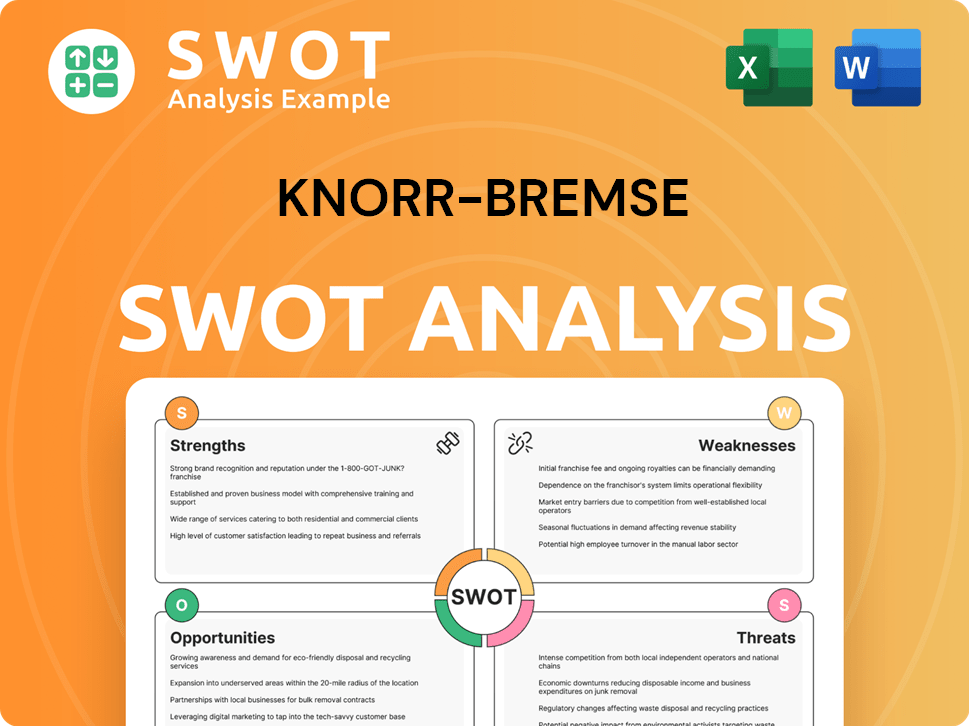
Who Are the Main Competitors Challenging Knorr-Bremse?
The Knorr-Bremse competitive landscape is shaped by a global market with both established giants and specialized players. The company faces significant competition in both the rail vehicle and commercial vehicle segments, requiring continuous innovation and strategic adaptation to maintain and grow its market position. Understanding the competitive environment is crucial for assessing Knorr-Bremse's financial performance and future prospects.
Knorr-Bremse's strategic positioning is constantly challenged by technological advancements and industry consolidation. The rise of autonomous driving and the shift towards electric vehicles are reshaping the competitive dynamics, influencing the demand for advanced braking and control systems. Analyzing the key competitors and their strategies provides insights into the challenges and opportunities facing Knorr-Bremse.
Knorr-Bremse's ability to secure large OEM contracts, innovate new safety and efficiency features, and expand its aftermarket service networks determines its success. The company must navigate a complex web of competitors, technological disruptions, and evolving customer demands to maintain its competitive edge. A thorough Knorr-Bremse industry analysis is essential for understanding its position in the market.
In the rail vehicle segment, Knorr-Bremse's primary competitors include major players that offer similar products and services. These competitors often vie for contracts with global rail operators and manufacturers. The competition is intense, driven by technological advancements and the need for efficient and reliable rail solutions.
Wabtec is a significant competitor, providing equipment, systems, digital solutions, and value-added services for the freight and transit rail sectors. It offers a comprehensive range of products that directly compete with Knorr-Bremse's rail braking and other sub-systems. Wabtec's broad portfolio and global presence make it a formidable competitor.
Siemens Mobility competes with Knorr-Bremse, particularly in integrated rail solutions and components. Siemens leverages its extensive portfolio beyond braking systems to offer comprehensive solutions. Their focus on integrated systems and digital solutions poses a challenge to Knorr-Bremse's market position.
In the commercial vehicle segment, Knorr-Bremse faces competition from companies with diverse product offerings, including braking systems, driveline, and chassis technology. These competitors challenge Knorr-Bremse through their broad product portfolios and established customer relationships. The competition is driven by the need for advanced safety and efficiency features.
ZF Friedrichshafen AG is a key competitor, offering a wide array of products, including braking systems, driveline, and chassis technology. ZF's commercial vehicle technology division directly competes with Knorr-Bremse in several product areas. Their extensive product range and global presence make them a significant player.
Bosch, through its Commercial Vehicle and Off-Road division, provides various systems, including braking control and driver assistance systems. Bosch competes with Knorr-Bremse by offering a range of advanced systems. Bosch's focus on innovation and technological integration poses a competitive challenge.
The competitive landscape is also influenced by emerging players and technological disruptions. Companies specializing in autonomous driving technologies and advanced sensor systems can influence the demand for integrated vehicle control systems. Mergers and acquisitions also reshape competitive dynamics, creating larger entities with expanded market reach. For example, in 2024, Wabtec acquired a significant portion of the Faiveley Transport business, strengthening its position in the rail market. This type of consolidation impacts Knorr-Bremse's market share and competitive position.
Several factors shape the competitive environment, including technological advancements, industry consolidation, and the shift towards electric vehicles. These factors influence the strategies of Knorr-Bremse and its competitors. Understanding these dynamics is crucial for Knorr-Bremse's strategic planning and future growth.
- Technological Advancements: The development of autonomous driving technologies and advanced sensor systems influences the demand for integrated vehicle control systems.
- Industry Consolidation: Mergers and acquisitions create larger, more formidable entities with expanded market reach.
- Electric Vehicles: The shift towards electric vehicles impacts the demand for braking systems and related technologies.
- OEM Contracts: Securing large OEM contracts is a critical battleground for competitors.
- Aftermarket Service Networks: Expanding aftermarket service networks is essential for maintaining customer relationships and generating revenue.
Knorr-Bremse PESTLE Analysis
- Covers All 6 PESTLE Categories
- No Research Needed – Save Hours of Work
- Built by Experts, Trusted by Consultants
- Instant Download, Ready to Use
- 100% Editable, Fully Customizable
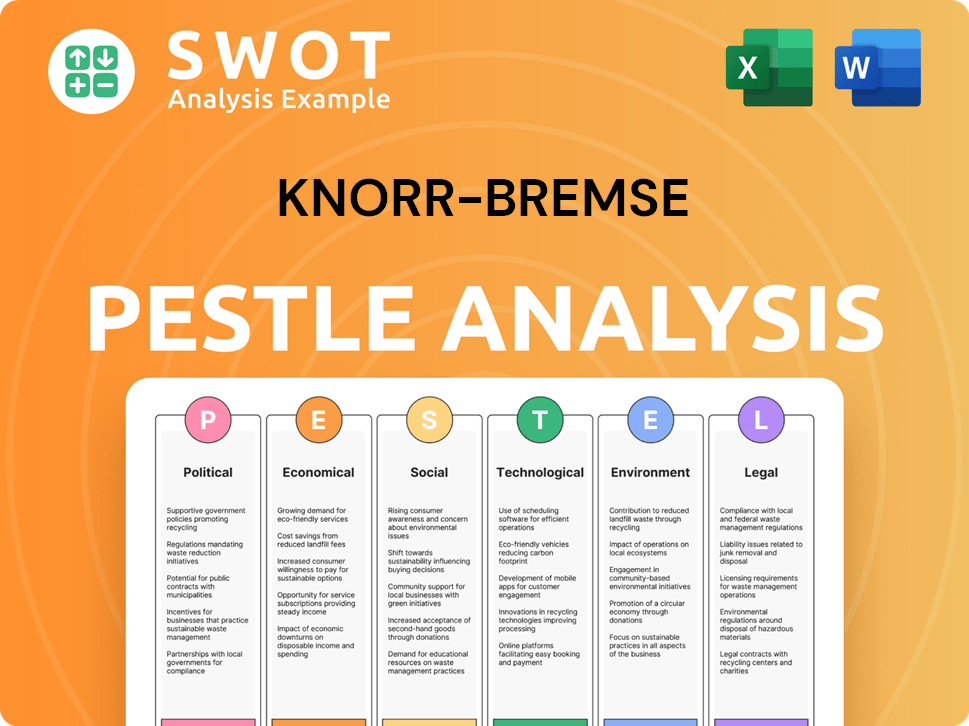
What Gives Knorr-Bremse a Competitive Edge Over Its Rivals?
The competitive advantages of Knorr-Bremse are built on a foundation of extensive expertise, technological leadership, and a well-established global infrastructure. These elements position the company strongly within the Knorr-Bremse competitive landscape. Its proprietary technologies and intellectual property in braking systems and related sub-systems for rail and commercial vehicles are key differentiators. The company's focus on innovation, with R&D investments, further solidifies its market position.
Knorr-Bremse has cultivated strong brand equity and customer loyalty over its long history. This reputation for reliability and quality makes it a trusted partner for major vehicle manufacturers and operators worldwide. The company's global network supports efficient supply chain management, allowing it to serve diverse markets effectively. This strong presence helps Knorr-Bremse maintain its competitive edge.
The comprehensive aftermarket service network enhances customer retention and provides a stable revenue stream. Knorr-Bremse integrates advanced electronics and software into its mechanical systems. This approach provides intelligent solutions for improved safety, efficiency, and automation. These advantages are crucial in the Knorr-Bremse industry analysis, helping the company maintain its competitive position.
Knorr-Bremse's technological edge is a core competitive advantage. The company holds numerous patents for advanced braking control and driver assistance systems. R&D expenses in 2023 totaled €430 million, representing 5.4% of its revenue, demonstrating a commitment to innovation. This continuous investment supports its market position in the braking systems market share analysis.
With over a century of experience, Knorr-Bremse has built a strong reputation for reliability and quality. This reputation fosters long-term relationships with vehicle manufacturers and operators. This strong brand presence is a key factor in the Knorr-Bremse competitive landscape.
Knorr-Bremse's global production and distribution networks provide economies of scale. Its comprehensive aftermarket service network enhances customer retention. This global reach is crucial for Knorr-Bremse's strategic overview.
The company integrates advanced electronics and software into its mechanical systems. This integration offers intelligent solutions for increased safety and efficiency. This approach supports its competitive advantages in commercial vehicles.
Knorr-Bremse's competitive advantages are significant, but it faces challenges from rapid technological advancements. The company's continuous innovation and strategic partnerships aim to sustain its leadership. For more details, you can explore the Revenue Streams & Business Model of Knorr-Bremse.
- Proprietary technologies in braking systems and related sub-systems.
- Strong brand reputation and customer loyalty.
- Extensive global production and distribution networks.
- Comprehensive aftermarket service network.
Knorr-Bremse Business Model Canvas
- Complete 9-Block Business Model Canvas
- Effortlessly Communicate Your Business Strategy
- Investor-Ready BMC Format
- 100% Editable and Customizable
- Clear and Structured Layout
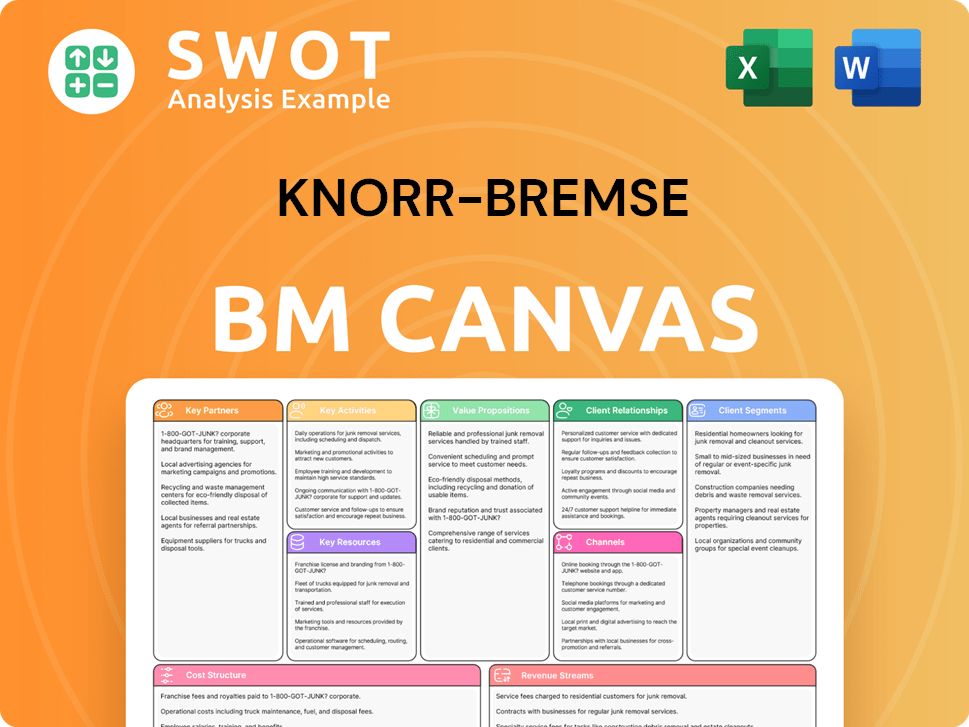
What Industry Trends Are Reshaping Knorr-Bremse’s Competitive Landscape?
The Knorr-Bremse competitive landscape is shaped by significant industry trends, including technological advancements, evolving regulations, and a rising emphasis on sustainability and digitalization. These factors influence the company's strategic direction and market positioning. Understanding these dynamics is crucial for assessing Knorr-Bremse's market share and future growth prospects.
The company faces both challenges and opportunities in a rapidly changing market. While advancements in autonomous driving and electromobility require substantial investment, they also present avenues for innovation. Regulatory changes and the increasing focus on digitalization further impact Knorr-Bremse's industry analysis, necessitating continuous adaptation and strategic responses.
Technological advancements, especially in autonomous driving and electromobility, are key drivers. The shift towards electric vehicles (EVs) and automated systems is reshaping the automotive and rail industries. Digitalization, including predictive maintenance and data analytics, is also transforming operations and service offerings.
New market entrants from the tech sector and aggressive pricing strategies could intensify competition. Economic downturns and supply chain disruptions pose risks to production and demand. Adapting to stringent regulations and continuous product innovation presents ongoing challenges.
Emerging markets offer significant growth potential due to infrastructure development and urbanization. Strategic partnerships, acquisitions, and investments in sustainable transport solutions can enhance market position. Expanding service offerings through software and data-driven solutions creates new revenue streams.
Focus on R&D to develop advanced braking and control systems for autonomous and electric vehicles. Form partnerships with tech companies to integrate software and data analytics solutions. Explore acquisitions to broaden product portfolios and market reach.
Knorr-Bremse's competitive advantages include its strong market position in braking systems and its technological expertise. The company faces competition from various players, including ZF Friedrichshafen and Wabco (now part of ZF). Understanding the Knorr-Bremse competitors is crucial for evaluating its market performance.
- Market Share: Knorr-Bremse holds a significant market share in the global braking systems market for commercial vehicles and rail.
- Innovation: Continuous investment in R&D, particularly in autonomous driving and electromobility, is vital.
- Geographic Presence: A strong global presence, especially in North America and Europe, is a key strength.
- Financial Performance: Analyzing Knorr-Bremse's financial performance, including revenue growth and profitability, is essential for a comprehensive Knorr-Bremse strategic overview.
For an in-depth look at how Knorr-Bremse approaches marketing and strategy, consider reading the Marketing Strategy of Knorr-Bremse. This provides additional insights into their market approach and competitive positioning. The company's ability to adapt to technological changes, regulatory demands, and market dynamics will determine its long-term success. The company's focus on innovation, strategic partnerships, and global expansion will be critical in navigating the evolving Knorr-Bremse competitive landscape. The company's strategic focus on sustainability and digitalization will also play a key role in its future performance. In 2024, the global automotive braking system market was valued at approximately $30 billion, with projections indicating continued growth driven by increasing vehicle production and safety regulations. The demand for advanced driver-assistance systems (ADAS) and autonomous driving technologies is expected to further fuel market expansion.
Knorr-Bremse Porter's Five Forces Analysis
- Covers All 5 Competitive Forces in Detail
- Structured for Consultants, Students, and Founders
- 100% Editable in Microsoft Word & Excel
- Instant Digital Download – Use Immediately
- Compatible with Mac & PC – Fully Unlocked
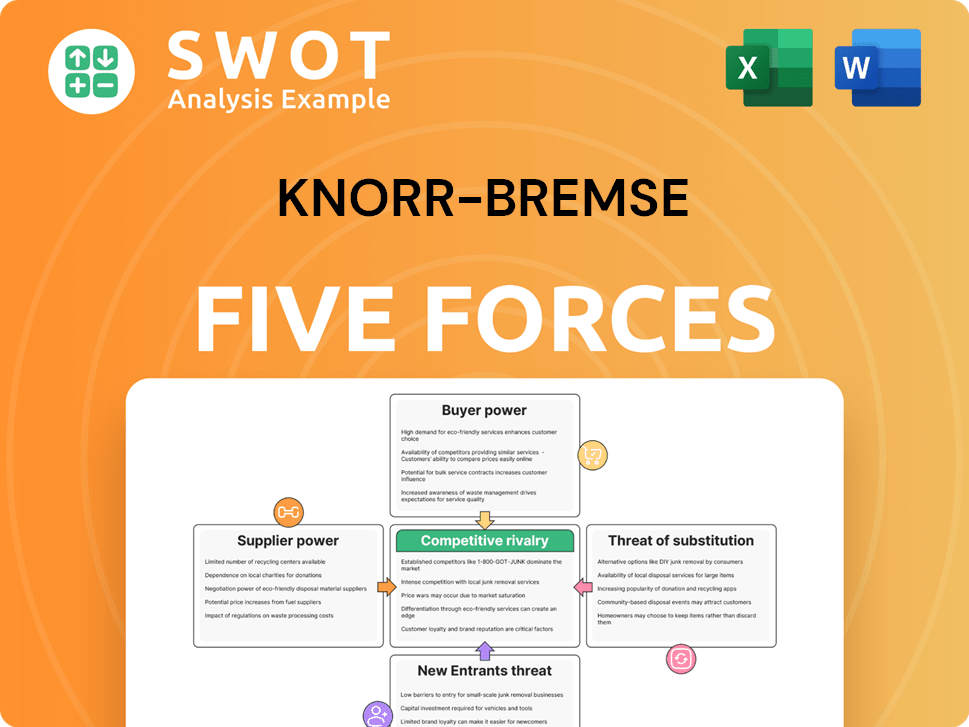
Related Blogs
- What are Mission Vision & Core Values of Knorr-Bremse Company?
- What is Growth Strategy and Future Prospects of Knorr-Bremse Company?
- How Does Knorr-Bremse Company Work?
- What is Sales and Marketing Strategy of Knorr-Bremse Company?
- What is Brief History of Knorr-Bremse Company?
- Who Owns Knorr-Bremse Company?
- What is Customer Demographics and Target Market of Knorr-Bremse Company?
Disclaimer
All information, articles, and product details provided on this website are for general informational and educational purposes only. We do not claim any ownership over, nor do we intend to infringe upon, any trademarks, copyrights, logos, brand names, or other intellectual property mentioned or depicted on this site. Such intellectual property remains the property of its respective owners, and any references here are made solely for identification or informational purposes, without implying any affiliation, endorsement, or partnership.
We make no representations or warranties, express or implied, regarding the accuracy, completeness, or suitability of any content or products presented. Nothing on this website should be construed as legal, tax, investment, financial, medical, or other professional advice. In addition, no part of this site—including articles or product references—constitutes a solicitation, recommendation, endorsement, advertisement, or offer to buy or sell any securities, franchises, or other financial instruments, particularly in jurisdictions where such activity would be unlawful.
All content is of a general nature and may not address the specific circumstances of any individual or entity. It is not a substitute for professional advice or services. Any actions you take based on the information provided here are strictly at your own risk. You accept full responsibility for any decisions or outcomes arising from your use of this website and agree to release us from any liability in connection with your use of, or reliance upon, the content or products found herein.